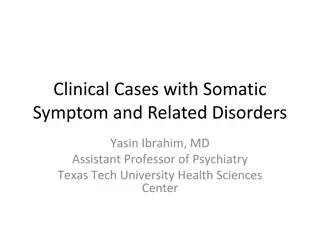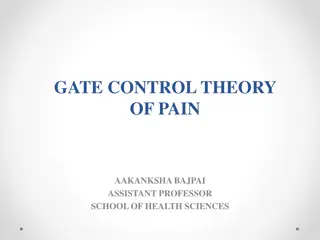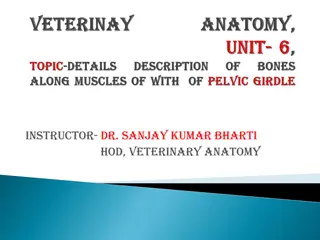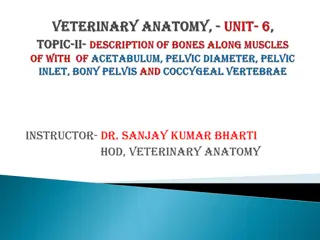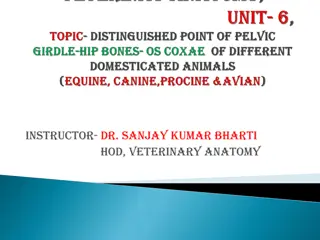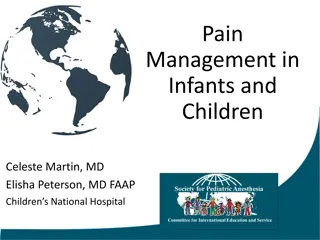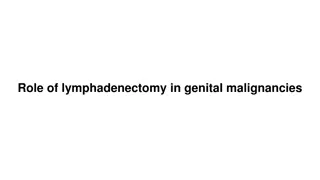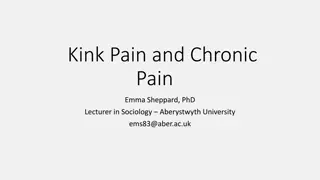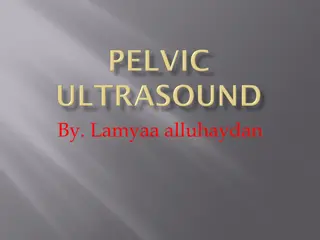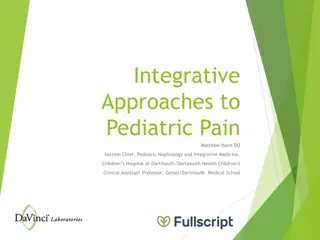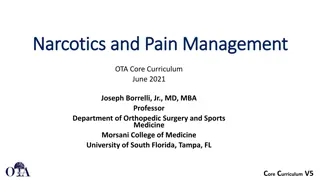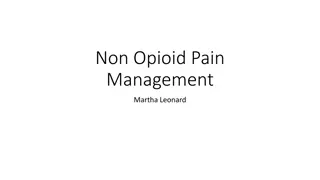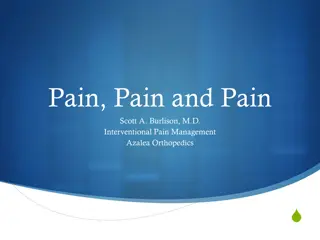Chronic pelvic pain
Polycystic ovarian chronic pelvic pain is characterized by recurrent pain lasting at least 6 months, unrelated to pregnancy, periods, or intercourse. It can lead to functional disability and affects various areas of the body. Causes include gynecological, urological, gastrointestinal, musculoskeletal, and other factors. Conditions like endometriosis, adhesions, and inflammatory diseases contribute to this chronic pain syndrome. Clinical assessment involves evaluating pain history and physical examination to determine the underlying issues causing the pain.
Download Presentation

Please find below an Image/Link to download the presentation.
The content on the website is provided AS IS for your information and personal use only. It may not be sold, licensed, or shared on other websites without obtaining consent from the author.If you encounter any issues during the download, it is possible that the publisher has removed the file from their server.
You are allowed to download the files provided on this website for personal or commercial use, subject to the condition that they are used lawfully. All files are the property of their respective owners.
The content on the website is provided AS IS for your information and personal use only. It may not be sold, licensed, or shared on other websites without obtaining consent from the author.
E N D
Presentation Transcript
.polycystic ovarian Chronic pelvic pain DR.Wassan Nori F.I.B.O.G 2019/2020
.polycystic ovarian Definition: recurrent pain of at least 6 months duration, unrelated to pregnancy, periods or intercourse; localizes to the pelvis, infraumbilical anterior abdominal wall, or lumbosacral back or buttocks; and leads to degree of functional disability
.polycystic ovarian causes of chronic pelvic pain in women 1.gynecological 2. urological 3. gastrointestinal :4. musculoskeletal: 5. others
causes a.extrauterine as adhesions, endometriosis, adnexal cysts, chronic pelvic inflammatory disease, chronic ectopic and residual ovary syndrome . b.uterine as adenomyosis, chronic endometritis, cervical stenosis
Definition: 2. urological As chronic urinary tract infection, renal stones and interstitial cystitis 3. gastrointestinal: Inflammatory bowel disease and irritable bowel syndrome .
Definition: PCOS is a syndrome of ovarian dysfunction whose . musculoskeletal: Coccydynia, disc herniation, fibromyositis, degenerative joint disease and faulty or poor posture. 5. others: Psychiatric disorders, shingles, neurologic dysfunction and abdominal cutaneoous nerve entrapment
Definition: Clinical assessment 1. pain history: -The onset and duration of the pain -location and radiation - exacerbating and relieving factors -relation to period and intercourse -severity and impact on quality of life - associated features
Definition: 2. physical examination: *general examination: - look for the gait of the patient -examination of the back -limitation of body movements may indicate orthopedic problem - ****Neurological examination to exclude neuropathies
Definition: abdominal examination: - inspection looking for scars and hernia - distinguish visceral from abdominal wall tenderness." Trigger point" tenderness elicited by palpation with one finger will suggest a nerve entrapment often involving the ilioinguinal or iliohypogastric nerve e.g. after surgery. - auscultation for bowel sounds, increased activity in irritable bowel syndrome
Definition: *pelvic examination: -*inspection of the vulva for any lesion, erythema as in vulvalvestibulitis, and thinning of vulvar skin as in lichen sclerosus - systematic pressure point palpation with a small cotton swab looking for site of tenderness as in vestibulodynia - digital examination for pelvic floor tenderness as in pelvic infection - retroverted uterus with nodularity in the pouch of Douglas suggest endometriosis - adnexal tenderness suggests pelvic congestion syndrome
Definition: 3. Investigations: A. Laboratory tests: *urinalysis and urine culture may reveal infection * TSH assay, thyroid disease can affect bowel and bladder function *random blood sugar as diabetes can lead to neuropathy *endocervical swabs to detect Chlamydia infection
Definition: B. Radiological imaging and endoscopy: *transvaginal ultrasound with Doppler study to detect uterine or adnexal pathology such as ovarian cyst *pelvic venography to diagnose pelvic congestion syndrome *CT or MRI, but add little information to sonography
Definition: *laparoscopy to diagnose and treat endometriosis and adhesions, newer laparoscopic approach is performed under local anesthesia and the patient is conscious and asked about the site of pain, this termed" conscious pain mapping *in bowel symptoms, barium enema and colonoscopy may be used
Definition: PCOS is a syndrome of ovarian dysfunction whose cardinal features were hyperandrogenism and Treatment: - If an identifying source is found then treatment will depend on the diagnosis - if no pathology is identified then treat the dominant symptoms
1.medical treatment : A. Analgesics: such as acetaminophen or NSAIDs , these are particularly helpful if inflammatory states underline the pain. If pain not relieved, then mild opiodcan be used such as codeine orhydrocodone. If pain persists, stronger opiods such as morphine and methadone can be used with regular follow up
B. Hormonal suppression: may be considered especially in those with co-existent dysmenorrhea or dyspareunia. Combined oral contraceptive pills, progestin such as medroxy progesterone acetate, gonadotrophin-releasing hormone (GnRH) agonist, and certain androgens have proven effective.
C. Antidepressants and anticonvulsants: tricyclic antidepressants such as amitriptyline have documented efficacy in the treatment of neuropathic and non- neuropathic pain syndromes. Anticonvulsants such as carbamazepine are used to reduce neuropathic pain. D. Polypharmacy: combining drugs may increase pain relief, for example a NSAID and an opiod may be used in inflammatory conditions
2. surgery: A. Neurolysis: involves nerve destruction or injection of a neurotoxic chemical. Presacralneurectomy and laparoscopic uterosacral nerve ablation (LUNA) involve destruction of nerve fibers to the uterus, these are useful for centrally located pelvic pain
B. Hysterectomy for patients with organic pathology, is effective in resolving pain and improving the quality of life. Oophorectomy may be indicated in patient whose pain respond to GnRH agonist therapy.however if the pain is neuropathic, surgery may make it worse
C. Lysis of pelvic adhesions (which may result from surgery, infection and endometriosis) may improve the pain, on the other hand may result in more adhesions, so decision to lyse adhesions should be individualized. d. Acupuncture D may benefit patients with dysmenorrhea
Cl E. Pelvic congestion syndrome attributed to the presence of pelvic varicosities(usually in multiparous women who present with pelvic pain, dysmenorrhea, and dyspareunia) may improve after radiological embolization
hirsutism Treatment aimed at reducing testosterone levels, this will not restore the hair to its pre-PCOS pattern but will slow the rate of hair growth. The treatment options include the following: Cyproterone acetate: A potent progestational, anti-androgen that competitively inhibits the androgen receptor. The combined preparations available are: Diane ( 2mg Cyproterone with 50micrograms Ethinyl estradiol, EE ) & Dianette ( 2 mg Cyproterone with 35 micrograms EE ), which can also be used for contraception. There is another regimen- the reverse sequential regimen where 100mg Cyproterone on days 5-14 is combined with 30 micrograms or 50 microgram EE on days 5-25.





